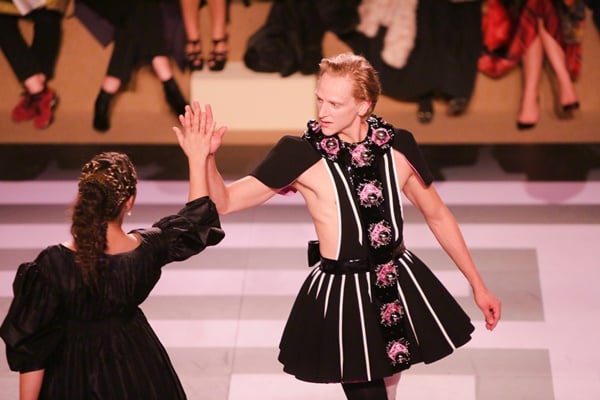
The schedule got off to an appropriately unsettling start at a musical brunch in Mark Kostabi’s town house on the Upper East Side. The artist was playing the piano, way too intent on the keys to notice my arrival; his brother Ena was on guitar. There were other musicians and a handwritten slate of the musical bill. I helped myself to a plateful of salad and walked around, but found nobody who was heading to the Francesco Vezzoli event for the opening of Performa at St. Bart’s. So I sat down.
A leaf of kale got stuck in my throat—I mean stuck–cue lurid, horror-movie sounds.
“Do you want a glass of water?” I was asked.
“Heimlich!” I gurgled.
A woman briskly applied the Heimlich, to positive effect.
David Hallberg.
Image: Courtesy BFA
So I moved on to St. Bart’s.
This great Romanesque church on Park Avenue—which had come to public attention decades before when the energies of Jackie Kennedy sheltered it, along with Grand Central Station and Lever House, from realtors—was the venue of Fortuna Desperata, the opening night event of Performa 15, which was commissioned from Vezzoli and David Hallberg.
Vezzoli is an Italian artist, a maker of performances and films in which he contrives to use both raw celebrity and the creative persona as his art materials. Hallberg is the lead dancer of both the American Ballet Theater and—since 2011—of the Bolshoi Ballet.
Francesco Vezzoli, RoseLee Goldberg.
Image: Courtesy BFA
He was standing in the center of the church wearing briefs as the viewers moved into the space, his muscle structure accentuated by what looked like make-up. And the “we” who moved in, well, this was the second and last performance (there were only two performances—back to back on November 1) and I saw Ann Pasternak of the Brooklyn Museum leaving and Klaus Biesenbach of MOMA PS1 arriving. It was that kind of crowd.
Fortuna Desperata turned out to be a dig into the early history of sex and dance. Deda Cristina Colonna, a dancer and period choreographer, constructed the dance using early records from the Renaissance, a time when dance was absolutely not performed by professionals in front of an audience but was part of the ritual of court life, performed by courtiers, as a representation of their private goings-on, either actual or ached after. You get much the same vibe in the dance sequences in early rock-and-roll movies.
That’s why I found it unsettling. We are used to ballet that tells stories, like Swan Lake, or ballet which is pure movement. But these six dancers were using their faces almost as much as they used their bodies.
Hallberg next wore a black-and-white kilt, one yellow boot and one red stocking. The other two guys were wearing hats that looked bafflingly familiar, baffling that is until Rainer Ganahl, the Austrian artist, whose own show I had seen a few days before, pointed out that they were Renaissance shapes.
Well, of course, they were. The three women had frizzed-out ponytails and floor-length dresses, a somewhat Napoleonic-era look.
The dancers danced together, and in changing patterns, and there was always a sense of intricate, ongoing stories, multiple and fluid. Their dresses were black, suggestive of mourning, but this look was belied by their expressive eyes, their half-smiles and moues, and their sweepings offstage, when one of the dance relationships was seemingly not working out.
The guys were dancing with the women, with each other, and Hallberg, very much the lord of the dance, would from time-to-time lock eyes with a member of the audience. Was he hitting on somebody? No. This, I understood, was just what a dancing courtier would have done back in the cinquecento.
Vezzoli was ebullient afterwards at a party in another space in St. Bart’s. “I’m in love with all of the dancers,” he said. “This is bisexuality without the sex.” I asked Colonna whether Fortuna Desperata was telling intricate stories. “Every dancer tells his own story,” she said.
Back to the party, where I circulated, talking to friends, and people I didn’t know, one of who said he was Ryan Gander, the British artist living in New York. “Ryan Gander” was carrying a linen bag. He fished out a key-chain, part of which was a sculpted bronze ballerina. He was selling them for $20, he said.
“Ryan Gander” explained that he had lost most of his money setting up a school. The subject of his need for dinner money came up. I acquired two key-rings, the second being attached to a pleasingly serrated engineering element. I also gave him my email details and suggested we speak another time.
At home, I Googled Ryan Gander and came upon a Guardian article: Use Your Imagineering – Ryan Gander’s art world of pranks and puzzles. It was illustrated by a photograph of Ryan Gander, who, as the alert reader may have guessed, was not the fellow I met at the Vezzoli event.
But, I did get an email from the real Ryan Gander, and a second email, attaching a screenshot of my handwritten email details. So the day ended as unsettlingly as it had begun, but rather more interestingly.